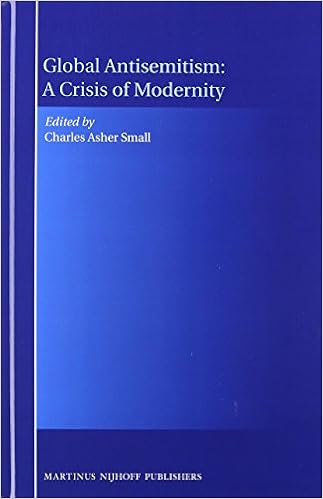
Antisemitism is a complex and, at times, perplexing form of hatred. Some observers refer to it as the “longest hatred.” It spans centuries of history, infecting different societies, religious, philosophical and political movements, and even civilizations. In the aftermath of the Holocaust, some have even argued that antisemitism illustrates the limitations of the Enlightenment and modernity itself. Manifestations of antisemitism occur in numerous ideologically-based narratives and in constructed identities of belonging and Otherness such as race and ethnicity, as well as nationalist and antinationalist movements. In the contemporary context of globalized relations, it appears that antisemitism has taken on new complex and changing forms that need to be decoded, mapped, and exposed. The academic study of antisemitism, like prejudice more generally, has a long and impressive intellectual and research history. It remains a topic of ongoing political importance and scholarly engagement. However, especially at this important historical juncture, unlike prejudice and discrimination directed at other social groups, antisemitism―in particular its contemporary forms and processes―is almost always studied outside an organized academic framework.
The process of globalization has led to an increase in adversarial identity politics. In this environment, Israel, as a central manifestation of contemporary Jewish identity, and Jews more generally have become the focus of scapegoating and hateful rhetoric. At a more structural and socio-historical level, the old ideologies and tendencies of antisemitism have re-emerged and are being fused with anti-Zionism or what in many cases might be more appropriately described as Israel-bashing. The old theological and racist forms of European antisemitism are being amalgamated with anti-Jewish and anti-Israel pronouncements emanating in particular from the Muslim world, which is located mainly, but not exclusively, in and around the Middle East. Contemporary globalization and the related socio-economic, cultural, and political processes are being fused with these historical tendencies, creating the conditions that pose a threat to Jewish people and Jewish communities in the Diaspora. In addition, new structural realities within the realm of theinternational relations and the emergence of anti-Israel propensities appear to pose a threat to Israel and the Jewish people in a manner not seen since the end of World War II. Once again, in this age of globalization, the Jewish people seem to be caught between the “aristocracy” or “wealthy establishment” (core) and the marginalized or disenfranchised masses (periphery), as they have been throughout most of history.
With the advent of the “socialism of fools,” a term describing the replacement of the search for real social and political equity with antisemitism that is frequently attributed to August Bebel, Jews continued to be targeted.9 In much the same way, the current marginalization of the Jewish people in the Arab world―or, more accurately, the marginalization of the image of the Jew, since most of them were pressured to leave or expelled from Arab countries between 1948 and the early 1970s after a strong continual presence of thousands of years―is staggering. As the social movements in the Middle East have turned to their own version of the “socialism of fools” (i.e., the antisemitism of radical political Islamism), they have incorporated lethal forms of European genocidal antisemitism as their fuel.10 However, many scholars, policy-makers, and journalists of record still refuse to acknowledge this fact and to critically examine the ideology and mission of this social movement.
Anti-Judaism is one of the most complex and at times perplexing forms of hatred. As
evident from the range of papers presented at the conference and in these volumes, antisemitism has many facets that touch upon many subjects and scholarly disciplines. The
term “anti-Semitism,” which was coined in the 1870s by Wilhelm Marr,11 is also cntroversial and at times confusing. Yet despite its etymological limitations and contradictions, it remains valid and useful. The term refers specifically to prejudice and discrimination against the Jewish people. Some incorrectly or for reasons of political expediency use the term to refer to prejudice against all so-called “Semitic” peoples,claiming that Arab peoples cannot be antisemites, as they are Semites themselves. This is fine in terms of etymological musing but not in terms of the history of language and thought, where terms acquire specific meanings over time that diverge from their etymological origins. In fact, antisemitism refers to a specific form a hatred that is mainly European in origin and focuses upon the Jewish people. Some scholars prefer to use the term antisemitism, without a hyphen and uncapitalized, since it refers to a form of hatred or a phenomenon rather than to a specific race or biologically determined group. Emil Fackenheim, for example, used the unhyphenated form for this reason.
This volume contains a selection of essays based on papers presented at a conference organized at Yale University and hosted by the Yale Initiative for the Interdisciplinary Study of Antisemitism (YIISA) and the International Association for the Study of Antisemitism (IASA), entitled “Global Antisemitism: A Crisis of Modernity.”
The essays are written by scholars from a wide array of disciplines, intellectual backgrounds, and perspectives, and address the conference’s two inter-related areas of focus: global antisemitism and the crisis of modernity currently affecting the core elements of Western society and civilization. Rather than treating antisemitism merely as an historical phenomenon, the authors place it squarely in the contemporary context. As a result, this volume also provides important insights into the ideologies, processes, and developments that give rise to prejudice in the contemporary global context. This thought-provoking collection will be of interest to students and scholars of antisemitism and discrimination, as well as to scholars and readers from other fields.
No comments:
Post a Comment